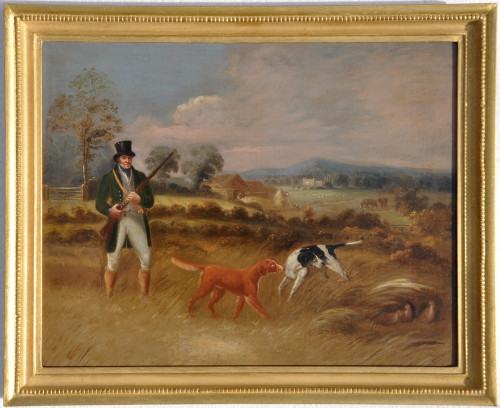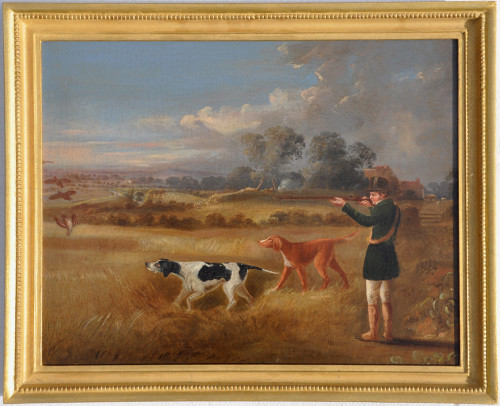Crescent New Moon over Canterbury Cathedral
Crescent New Moon over Canterbury Cathedral
EDMUND JOHN NIEMANN
English School
1813-1876
Crescent New Moon over Canterbury Cathedral
Oil on board, signed and dated 62
17.4 x 50 cms
67/8 x 193/4 inches
Overall framed size 43.3 x 76.4 cms
171/8 x 301/8 ins
Edmund John Niemann was a landscape, marine and occasional sporting painter who was best known for his depiction of the scenery in the environs of the River Thames and the River Swale near Richmond in Yorkshire.
He was born in Islington, north London, the son of John Diedrich Niemann, a member of Lloyd’s who had come from Minden in Westphalia to work in the City. Edmund himself started working as a clerk at Lloyd’s at the age of thirteen, remaining there until 1839 when he resolved to pursue a career as an artist.
He lived at addresses in north and south London and also Wooburn Green, near Beaconsfield and High Wycombe in Buckinghamshire from where he sent his early exhibited paintings at the Royal Academy and British Institution. He preferred to work outdoors and this proximity to nature and his subject matter was translated in to the painting where the vibrancy of his portrayal gave the piece depth and atmosphere. There is a naturalness in his colour palette and the landscape is realistically rendered without unnecessary embellishment.
Apart from his penchant for Thames and Richmond in Yorkshire views, Niemann travelled widely in Britain seeking subject matter and this is reflected in the large number of paintings held by museums and institutions who were keen to acquire records of their local environs. In 1856 and 1857, he entered also some paintings of Rhineland views at the Royal Society of British Art. In total, between 1844 and 1872, he showed a further thirty-eight works at the RBA, twenty-nine at the Royal Academy, forty-five at the British Institution and over sixty at other venues including Liverpool Academy of Arts, Manchester Academy of Fine Arts, Glasgow Institute, Royal Scottish Academy and the Paris Salon. Some examples of these include: Canterbury – Sunrise; The lime kiln at Cove’s End, Wooburn, Bucks; The Fish Market, Norwich with the church of St Peter Mancroft; Running for port – storm coming on; Wreck on Whitby Scarr; The city of Gloucester; Morning on the Welsh mountains; Recollections of the Rhine; Richmond, Yorkshire; View near Atherstone, Tamworth in the distance; Ballast-getting on the Thames near Cookham Weir – effect after rain; Lincoln.
Although almost exclusively a painter of landscapes, Niemann did produce a small number of marines and sporting paintings. The latter were mostly of fishing subject matter with a Royal Academy exhibit Biting time being one example. The renowned A N Gilbey collection of angling paintings had several examples of his works in it including: A view of a mill near Trefiw, North Wales with an angler fishing from rocks in the foreground; An angler seated on a rocky bank in the Highlands and Angling on the Thames at Cookham.
Towards the end of the 1840s, a group of artists including Niemann, became increasingly dissatisfied with the way that some influential art exhibition venues and societies ran these institutions which could be perceived as narrowing into cliques. In 1848 the Free Exhibition was set up and the inaugural show was staged at the Chinese Gallery near to Hyde Park Corner. The exhibition was comprised of over five hundred works of art including sculpture. It relocated to Regent St and was held at the Portland Gallery with Niemann becoming the Honorary Secretary and one of the Trustees. It later became the National Institution but its existence was comparatively short-lived with 1861 marking the last exhibition.
E J Niemann had a son Edward H who painted very much in the same vein as his father but without the same level of skill and depth of palette. The father struggled with ill health for the last few years of his life and died suddenly from apoplexy on 15th April 1876 at Brixton Hill in Surrey.
Museums and institutions that hold examples of his work include: Victoria and Albert Museum; Bank of England Museum (which has a very large View of the Thames from Waterloo Bridge (167 x 342 cms); Museum of London (Buckingham St, Strand); Government Art Collection; Windsor Royal Borough Museum; Tower Hamlets Local History Library; Orleans House; Canterbury Museum and Galleries; Croydon Museum; Wolverhampton Art Gallery, Nottingham City Museum and Galleries; Sheffield Museum (14 paintings), Rotherham Museum; Shipley Art Gallery; Leeds Art Gallery; Cooper Gallery, Barnsley; Walker Art Gallery, Liverpool; Blackburn Museum and Art Galleries; Stockport Heritage Services; Wigan Arts and Heritage Services; Calderdale Metropolitan Borough Council; Alkinson Art Gallery, Southport; Sunderland Museum; Laing Art Gallery; Astley Hall Museum and Art Galleries; Calderdale Museum and Galleries; Herbert Art Gallery; Russel-Cotes Art Gallery; University of Nottingham; Leicester Museum and Art Gallery; Towneley Hall Art Gallery; Usher Gallery, Lincoln; Leamington Spa Art Gallery; Shrewsbury Museum; Museum of Gloucester; Bristol Museum and Art Gallery; Salisbury Museum; Royal Cornwall Museum; Reading Museum; Wycombe Museum; Buckinghamshire County Museum; Brighton and Hove Museum; Tamworth Castle; Maidstone Museum; Colchester and Ipswich Museum; Anglesey Abbey (National Trust); Audley End (English Heritage); Green Howards Regimental Museum; Dundee Fine Art Collection; Glasgow Museum; Kirklees Museum and Gallery; Paisley Museum and Art Gallery, National Library of Wales and National Gallery of New South Wales, Sydney.
Bibliography:
Dictionary of Victorian Painters – Christopher Wood
Dictionary of Sea Painters – E H H Archibald
Dictionary of British Landscape Painters - M H Grant
Dictionary of British Marine Painters - Arnold Wilson
Dictionary of British Sporting Painters – Sydney H Paviere
Dimensions:
RELATED ITEMS























